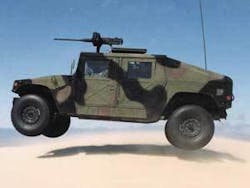By Ben Ames
WASHINGTON - The U.S. Army moved a step closer to developing a next-generation tactical utility truck to replace the Humvee and other familiar vehicles last month, as it narrowed the competition from four companies to two.
Army leaders selected International Military and Government LLC and Lockheed Martin Corp. to build demonstrator armored vehicles for the Future Tactical Truck System (FTTS) program.
The Army’s Tank-automotive and Armaments Command (TACOM) in Warren, Mich., awarded $12.25 million to International and $9 million to Lockheed Martin, requiring each to build one demonstrator vehicle over the next 18 months.
Other competitors included Stewart & Stevenson Vehicle Services Inc., and AM General Corp., the manufacturer of the Army’s current high mobility multi-wheeled vehicle (HMMWV, or “humvee”).
In a departure from using trucks that are simple workhorses, Army leaders have required that each vehicle be packed with electronics.
For example, the International bid includes the latest truck electronics, tracking, logistics, body-equipment integration, hybrid capabilities, electronic engines, and external power sources. Its electronics/telematics feature advanced architecture, diagnostics and prognostics, satellite solutions, and geofencing (restricting the movement of a vehicle to within a specified area).
“The Army is seeking several key technologies-from embedded simulators and diagnostics and prognostics technologies to movement-tracking systems and mobility and fuel-savings features-and International already has many of the capabilities to supply a tactical utility truck that delivers what our troops require over the most rugged, extreme and dangerous conditions,” says Archie Massicotte, president of International’s military and government business. International Military and Government is a subsidiary of Navistar International Corp., Warrenville, Ill.
Likewise, a major reason Lockheed Martin won further funding was the digital network capabilities demonstrated in its LM4x4 FTTS utility vehicle during the initial modeling and simulation phase, which concluded in September.
Lockheed Martin’s vehicle also showed improved survivability and safety, enhanced vehicle reliability, and maintainability and range, the company says.
The FTTS award comes less than two weeks after Lockheed Martin UK Holdings Ltd. announced that it had acquired HMT Vehicles Limited, a United Kingdom-based developer of designs for military vehicles. Lockheed Martin plans on incorporating HMT’s designs into its U.S. programs such as the Army’s FTTS.
Under the new contract, Lockheed Martin will now build an LM4x4 FTTS utility vehicle for delivery to the Army later this fall. The truck will then undergo a Platform Systems Demonstration and a Military User Assessment.
“The ACTD’s second phase is an important step in developing the requirements for safer and more survivable vehicles for our warfighters,” says Louis J. De Santis, vice president and general manager of integrated products at Lockheed Martin Systems Integration, in Owego, N.Y. “We look forward to working with the Army to build a technology demonstration truck that will help the service refine the requirements for the 40,000-plus vehicles that will eventually replace the Humvee.”
The FTTS program includes both a utility vehicle to replace the Humvee and a heavier vehicle to replace current medium tactical vehicles and the heavy fleet of cargo trucks.
Army leaders also say the new design must be modular, allowing soldiers to configure the vehicle to match each mission. And they demanded trucks that can perform well with the added weight of armor. That has been a major problem for soldiers in Iraq, who complain about an increase in rollover accidents in Humvees that bear enough armor to protect them from roadside bombs and rocket-propelled grenades.




